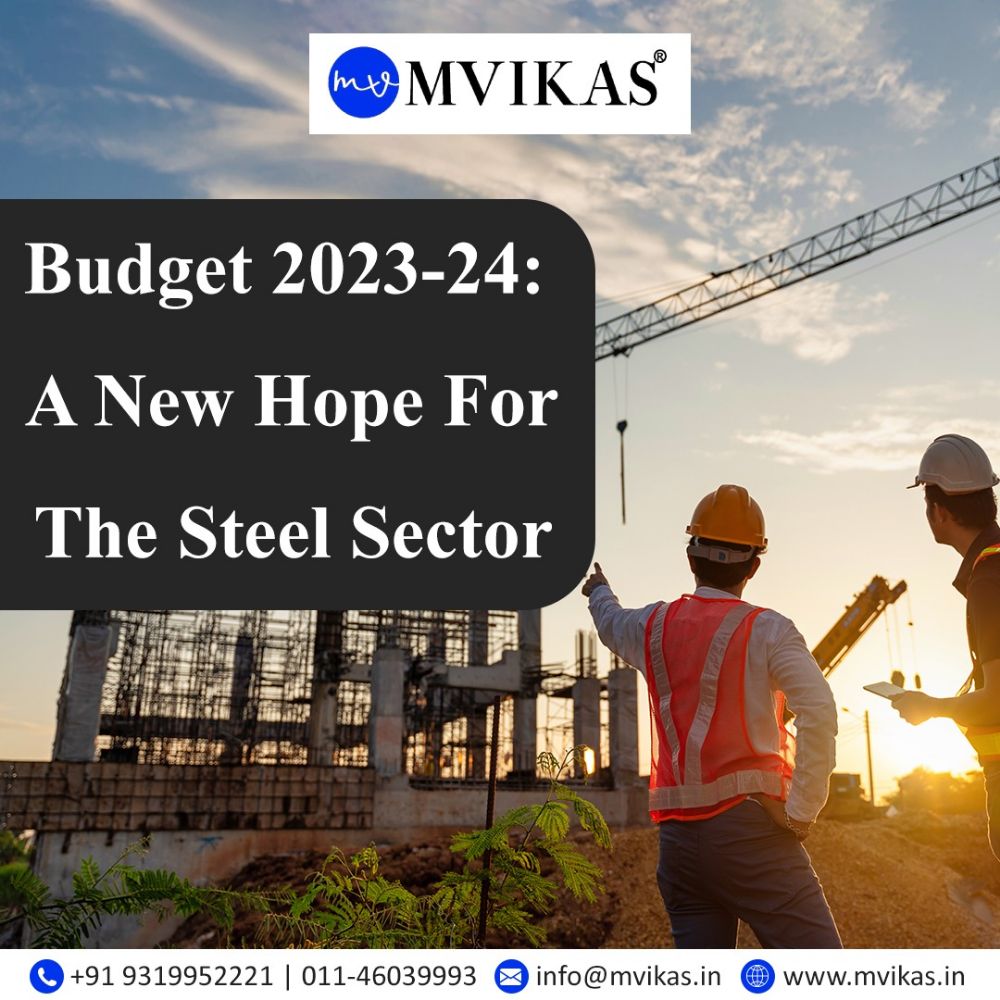Reachable at 9560662883  011-46039993 (Ext. 21 to 32) (10am - 06pm)
011-46039993 (Ext. 21 to 32) (10am - 06pm)
Budget 2023-24: A New Hope For The Steel Sector

The steel industry has experienced significant changes in recent years and will face various disruptive elements in the future. The increased investment in infrastructure, housing, and logistics, as well as the emphasis on green energy, are favourable for the cement and steel industries. The steel industries have benefited from the Rs 10 trillion infrastructure fund allocated in the Union Budget for 2023-24.
Current Global Market – Steel Manufacturing
The worldwide steel market was worth around Rs. 1 lakh crore (approximately) in 2020. However, the Covid-19 epidemic significantly influenced steel demand and the steel industry's capacity to produce and transport steel due to lockdown laws and mobility limitations. Steel output declined to 158.1 lakh crore (approximately) metric tonnes in June 2022, a 5.9% decrease from the same month in 2021.
Steel is predicted to come back in 2023, though it will not entirely recover from the supply and demand disruption created by the pandemic. Consumption fell in the second half of 2022, and this trend will likely continue into 2023. Steelmakers' revenues are projected to be lower this year.
How will the new Union Budget for 2023-24 impact the steel sector?
The government's continuous emphasis on infrastructure in the Union Budget 2023-24 would assure long-term growth in steel demand. In the Budget, Finance Minister Nirmala Sitharaman boosted the country's capital expenditure for infrastructure development to Rs 10 lakh crore. The extension of the duty waiver on ferrous scrap, raw materials used in Cold Rolled Grain Oriented (CRGO) production, and nickel cathode is a good move for the steel sector. Overall, steelmakers might conclude that this is a solid budget.
The removal of 'export duty' on finished steel and iron products following inclusion in the RoDTEP scheme had already been announced. Before the budget, the inclusion of 'specialty steel' under the PLI scheme has been lauded by steel makers as it will further boost 'Make in India' while adding to the 'Aatmanirbhar Bharat' narrative.
Budget 2023 impact: Steel Demand to Strengthen, But Not Prices
The steel industries have benefited from the Rs 10 trillion infrastructure fund allocated in the Union Budget for 2023-24. Even if a surge in demand is projected, the costs of some building materials may stay low. Among the important budget announcements that have boosted the confidence of steel and cement companies are a 33% increase in allocation for significant infrastructure sectors and a 66% increase in outlay for the Pradhan Mantri Awas Yojana (PMAY).
The highest-ever price for railways in the last decade, and plans for 50 new airports. Each of them will likely add to the already strong demand for steel and cement. Cement consumption is likely to rise due to the infrastructure and building boom. Increased investment in railroads and fifty new airports also benefits the business. Analysts at Angel Broking observed in their budget assessment that PMAY would assist in increasing demand for housing developments, which will benefit all cement businesses.
Metals will benefit from last-mile attention and sustainable energy announcements. In addition to the expected boost in demand from increasing infrastructure and housing expenditure, industry insiders see further benefits. Announcements on improving first- and last-mile connectivity will likely simplify logistics for the metals sector. The development of last-mile connectivity is a huge benefit for the sector. Transportation expenses rise to almost 8% of GDP globally and 12-14% of GDP in India. So any relaxation from resolving transportation difficulties is good.
Finance Minister Nirmala Sitharaman stated in her budget address that 100 essential infrastructure projects
For the ports' first- and last-mile connectivity, coal, steel, fertilizer, and food grains sectors had been identified. The projects would be prioritized and require an expenditure of Rs 75,000 crore, including Rs 15,000 crore from private sources. Executives in the Steek sector are likewise optimistic that focusing on green capex would help the industry satisfy its energy demands. The government's emphasis on green capital spending would assist in handling the industry's energy demands.
The Price Challenge
JSW Steel recorded its highest-ever December quarter crude steel output. For the first three quarters of the current fiscal year, UltraTech Cement achieved a double-digit volume increase. Due to rising infrastructure and housing investment, steel and cement demand in India has been increasing. The current budget allocations will amplify the demand growth narrative. However, only some are convinced it will result in long-term price increases. Can price increases be sustained in the face of growing demand?
Cement prices have already reached a two-year high due to persistent inflationary pressures. Cement businesses will need to focus more on cost reduction for profit expansion. Domestic demand is strong, bolstered by rising infrastructure expenditure and growth in the building, industrial, and car industries.
The Future of Steel Industry: A Capabilities Perspective
The steel industry has experienced significant changes in recent years and will face various disruptive elements in the future. Instead of responding to market trends, industry participants should build the future to be successful in the future. For this, businesses must commit to an identity centred on how they generate value for consumers. The few capabilities that enable them to outperform everyone else, then update and expand those few capabilities that is essential to their success.

Leave your comment